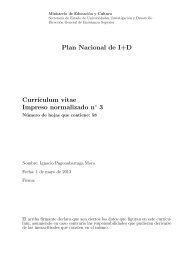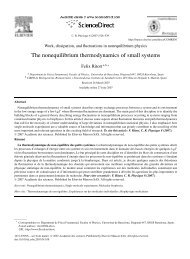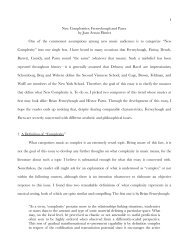Physica A Precursors of long-range order and local disorder in colloids
Physica A Precursors of long-range order and local disorder in colloids
Physica A Precursors of long-range order and local disorder in colloids
Create successful ePaper yourself
Turn your PDF publications into a flip-book with our unique Google optimized e-Paper software.
1976 M. Mayorga et al. / <strong>Physica</strong> A 388 (2009) 1973–1977Fig. 3. This image shows a rotation <strong>of</strong> Fig. 2 from which one can better observe the presence <strong>of</strong> orientational <strong>long</strong> <strong>range</strong> <strong>order</strong>. The pack<strong>in</strong>g fraction is alsoη = 0.545 which corresponds to the same conditions given <strong>in</strong> Fig. 2 but the figure has been slightly rotated to capture the correspond<strong>in</strong>g view.Fig. 4. Pair correlation function for our model potential plotted versus reduced distance r ∗ , for two different β parameters. The cont<strong>in</strong>uous l<strong>in</strong>e is forβ = 11.910 <strong>and</strong> β = 11.905 for the dash l<strong>in</strong>e, for both cases α = 0.945 <strong>and</strong> η = 0.494. In this case, the shoulder is no <strong>long</strong>er flat. The particles becomearrested, giv<strong>in</strong>g rise to dis<strong>order</strong>ed configurations which have been found experimentally. The <strong>in</strong>set enhances the shoulder <strong>of</strong> the cont<strong>in</strong>uous plot whichshows qualitative agreement with the glassy precursor obta<strong>in</strong>ed experimentally <strong>in</strong> Refs. [17,21].fraction η = 0.494. The correspond<strong>in</strong>g correlation functions are shown <strong>in</strong> Fig. 4. This function is similar to the one observed<strong>in</strong> experiments for PMMA particles immersed <strong>in</strong> a mixture <strong>of</strong> decal<strong>in</strong> <strong>and</strong> cycloheptylbromide, that were reported <strong>in</strong> theFigure 4(b) <strong>of</strong> Ref. [17]. The lower value <strong>of</strong> β corresponds to an <strong>in</strong>crease <strong>of</strong> the diffusion <strong>of</strong> particles <strong>in</strong> comparison withthe <strong>order</strong>ed case. As a consequence, the shoulder <strong>in</strong> g appears at the right-h<strong>and</strong> side <strong>of</strong> the second maximum, lead<strong>in</strong>gto the appearance <strong>of</strong> cages, one <strong>of</strong> the features <strong>of</strong> <strong>colloids</strong> close to glass transition [17,21], which can be considered asa sign <strong>of</strong> an amorphous-structure precursor. The above observation establishes that there is a crystallization w<strong>in</strong>dow(i.e. β > 11.910) for which the crystallization can be <strong>in</strong>duced, <strong>in</strong>creas<strong>in</strong>g the volume fraction. So, decreas<strong>in</strong>g β belowthat value, the crystallization is frustrated, result<strong>in</strong>g <strong>in</strong> a dis<strong>order</strong>ed structure.4. ConclusionsWe have shown the existence <strong>of</strong> structural precursors <strong>of</strong> <strong>long</strong>-<strong>range</strong> <strong>order</strong> <strong>and</strong> <strong>local</strong> dis<strong>order</strong> <strong>in</strong> <strong>colloids</strong>, which can beidentified as shoulders around the second peak <strong>in</strong> the pair correlation function. The presence <strong>of</strong> a shoulder on the left (right)side is the signature <strong>of</strong> <strong>long</strong>-<strong>range</strong> <strong>order</strong> (<strong>local</strong> dis<strong>order</strong>) <strong>in</strong> colloidal suspensions. Its position depends on the value <strong>of</strong> as<strong>in</strong>gle parameter that modulates the effective width <strong>of</strong> the attractive well <strong>in</strong> the <strong>in</strong>teraction potential. These <strong>in</strong>terest<strong>in</strong>gf<strong>in</strong>d<strong>in</strong>gs may contribute to a deeper underst<strong>and</strong><strong>in</strong>g <strong>of</strong> the models that can be proposed to study phase transitions <strong>in</strong> colloidalsuspensions [22].





